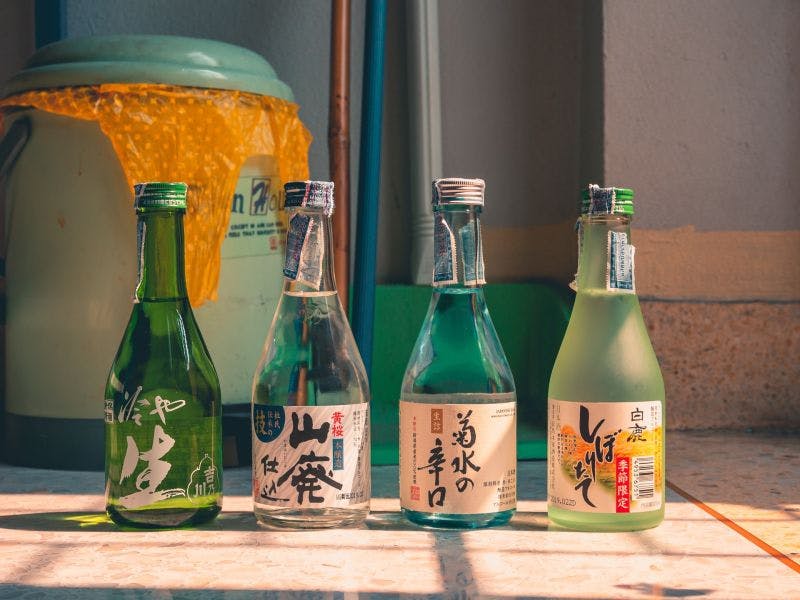your cart
Your cart is empty.
How to Drink Japanese Sake: A Guide to Japan’s National Drink
are gaining popularity in the western world, so now is the perfect time to try sake if you haven't already! While versions of sake have been enjoyed in Japan for centuries, recent years have seen the drink garner more widespread global interest.
The rice-based alcoholic drink we know as ‘sake’ is Japan’s national drink, but what makes this beverage so special?

Japanese alcohols are gaining popularity in the western world, so now is the perfect time to try sake if you haven't already! While versions of sake have been enjoyed in Japan for centuries, recent years have seen the drink garner more widespread global interest. The rice-based alcoholic drink we know as ‘sake’ is Japan’s national drink, but what makes this beverage so special?
Drinking sake is steeped in tradition and rich history. Find out how Japanese sake is best enjoyed to begin your foray into the world of Japanese alcohol and cuisine.
What is Sake?
In Japan, the word sake actually just refers to any kind of alcoholic drink; what you may know as ‘sake’ is called ‘nihonshu’ in Japan. The drink is made by fermenting special varieties of sake rice known as shuzokotekimai. In this respect, sake is more similar to grape wine rather than spirits like whiskey as it is not distilled. However, sake-making methods are more similar to that of beer brewing, making it a unique drink that’s distinct from any other!
What Does Sake Taste Like?
If you’re new to sake, the main thing you’re probably wondering is what it tastes like. As sake is a kind of wine, many describe it as tasting like a dry white grape wine. It has a mild, slightly sweet taste with a hint of umami; it tends to have a higher acidity than beer but lower than wine. Like any other kind of wine, you’ll come across different varieties of sake that offer different notes and have been made with varying brewing techniques. What’s known as the Sake Metre Value illustrates whether the drink is dry or sweet. A higher SMV will indicate a drier sake, while a lower number means the drink is sweet. Experiment with different levels of SMV to find the perfect drink for you! Ozeki sake is particularly popular, and offers a good selection of different sake types. Why not pair your sake with a popular Japanese dish for an even more flavourful experience?
How Strong is Sake?
Some may be under the impression that because sake is clear and often in small shot glasses, it is akin to vodka or other spirits. This is not the case. Most sake is around 15% ABV, which makes it a little bit stronger than the majority of grape wines.
(If you're after a non-alcoholic Japanese drink, ramune is one of the nation's favourite!)
How is Sake Made?
Before the fermentation process can begin, the grains of brown rice must be ‘polished’ to mill away the outer layer until the starchy core is exposed. The rice is then washed, and a cultured mould known as koji is added. The rice, koji and water are combined in a fermentation tank to create a fermentation mash which is pressed and bottled. This, of course, is a simplified version of the process, and different brewers may have their own unique techniques to create different kinds of sake.
How to Drink Sake – Japanese Sake Etiquette
Now you know the what, let’s consider the how. Traditionally, sake is a ceremonial drink, enjoyed at celebrations and symbolising tying people together and starting afresh. As the drink plays an important part in Japanese culture, there are numerous etiquette rules showing how it should be drunk. Although sake is now often enjoyed in more casual settings, many are still conscious of the rules set out centuries ago.
1. Never Serve Yourself Sake
If drinking in a group setting, it is custom to pour one another’s drinks. Pouring your own sake is considered rude in Japan and is known as tejaku.
2. Pour With Both Hands
When pouring your companions’ drink, use both hands to pour the sake into their cup. You should be especially mindful of social and work hierarchies with this custom; if pouring for a senior, always use both hands; if pouring for your junior, you can use one hand.
3. Drink From the Ochoko with Both Hands
Traditionally sake is poured from a ceramic flask known as a tokkuri into a small cup known as an ochaku. When receiving your sake, you should also use both hands, one to cup the ochaku in the palm and the other cradling the side.
4. Don’t Drink Sake Like a Shot
Because it tends to be served in a small shot-like cup or glass, you might be tempted to shoot sake. But you should not drink it like this. Sake should be sipped and enjoyed. Once you have finished a cup, your companions will fill it for you.
5. Start Drinking When Everyone’s Cup is Full
Everyone should only start drinking once everyone’s sake has been poured and a toast has been made by saying kanpai, which loosely translates to ‘drink your cup dry’ or is another way to express ‘cheers’.
6. Know Your Sake
Get to know the different varieties of sake to find a flavour and body that suits you! Among the world of oriental drinks, there are plenty of sake options to explore.
Should You Drink Sake Hot or Cold?
Whether you drink sake hot or cold will primarily depend on the kind of sake – some will suit being hot while others are better enjoyed chilled. Premium sake tends to be best served colder as the flavour is more enhanced and refined, while sake of lower quality can often be served warm as this takes away some of the bitterness.
Different Kinds of Sake
Sake can differ due to numerous factors, including the rice that is used, how much it has been polished, the particulars of the brewing and filtration process and more. Various types of sake you’ll come across include:
- Junmai (at least 70% polished ‘pure rice’ without any additives)
- Honjozo (uses 70% polished rice with the addition of distilled brewers alcohol)
- Ginjo (60% polished rice for a premium sake)
- Daiginjo (precisely-brewed sake with 50% polished rice)
- Shiboritate (unaged sake)
- Nama-zake (unpasteurised sake)
- Nigori (cloudy, coarsely filtered sake)
- Jizake (regional sake)
How to Store Sake
Once you’ve decided on the kind of sake you want to drink, you’ll need to ensure you know how to properly store it, so you get the best drinking experience again and again.
Where to Buy Sake in the UK
You’ll be able to find sake in your local Asian supermarket. As the drink’s popularity grows outside of Japan, it’s also making its way into mainstream UK supermarkets too! If you want an even more convenient option, there are plenty of ways to buy sake online. Here at Oriental Mart, we stock a range of sake, including dry, sweet and sparkling sake. Whether you can’t wait to try it for the first time or are a sake connoisseur, we’re sure to have something to pique your interest. If you’re interested in finding out more about Asian alcohols, read our ultimate guide to soju, Korea’s national drink.
this site uses cookies
We and our advertising partners use cookies on this site and around the web to improve your website experience and provide you with personalised advertising from this site and other advertisers. By clicking allow, you accept the placement and use of these cookies for these purposes. Learn More



